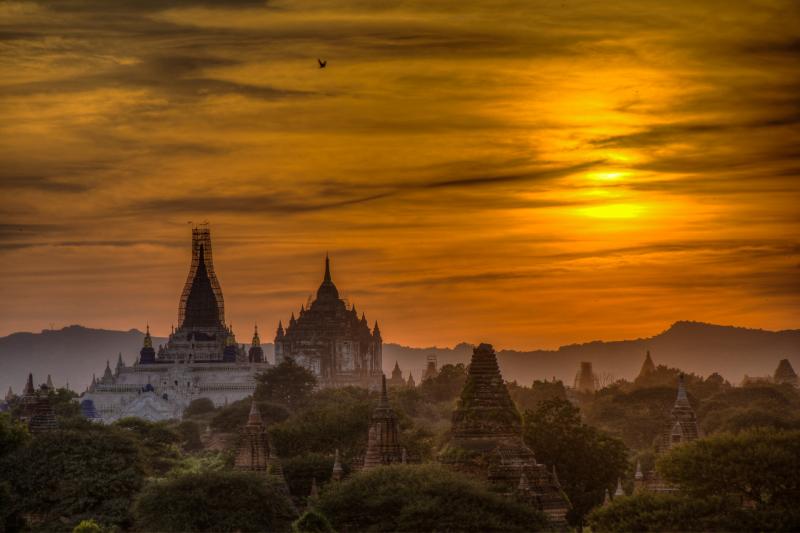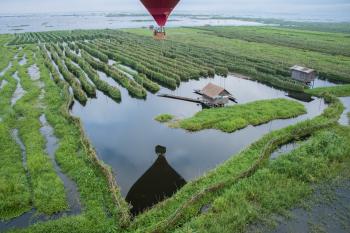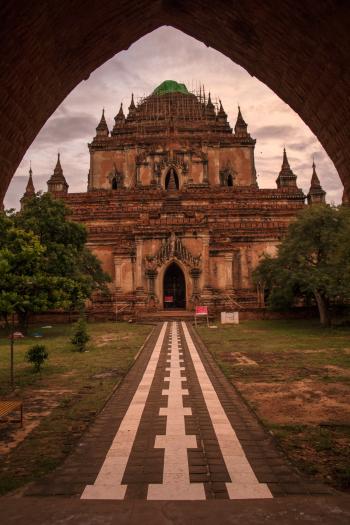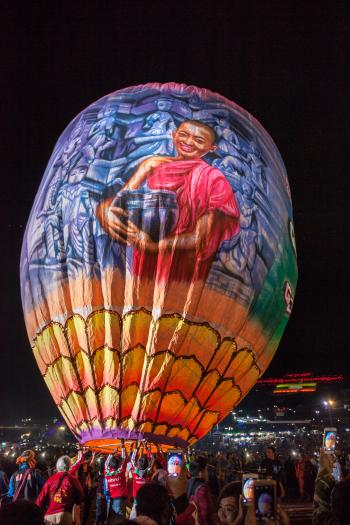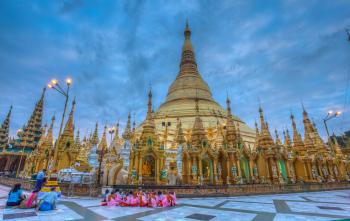Finding an abundance of authentic experiences on a private tour of Myanmar
This article appears on page 20 of the May 2017 issue.
With Myanmar’s turn from military rule to a civilian government, beginning in 2011, tourism to that country has been growing rapidly. My wife, Jill, and I wanted to explore Myanmar before mass tourism, with its herds of people and anticipated commercial blight, began to set in, so we spent six wonderful weeks visiting the country beginning Nov. 1, 2016.
Making plans
We are independent travelers (I look forward to group travel about as much as a colonoscopy), so I combed guidebooks to sketch out an itinerary before contacting Myriam Grest Thein of Myanmar Travel (Yangon, Myanmar; phone +95 9 7325 9401, www.myanmartravel.net), a company I found in ITN. We worked out a detailed itinerary over several months.
In addition to seeing Myanmar’s major attractions, we wanted to visit various rural areas to see how people really lived away from the tourist “hot spots.” We were not disappointed.
Any stay of more than four weeks requires a business visa, which we obtained online without hassle.
We selected November to December for our trip because the rainy season is typically over by the end of October, but in 2016 it hung on for three weeks longer than usual, causing several cloudy days though no serious rain.
For a developing country that is just “opening up,” Myanmar had a high-quality tourism infrastructure that was a pleasant surprise. Almost all of our hotels exceeded our expectations; transportation was efficient and on time (with the exception of a couple of internal airlines); there was decent Wi-Fi in many places, and all of our guides were top-notch — very personable, accommodating and knowledgeable.
Yangon to Mandalay
We began and ended our stay in Yangon, where the major attraction is, of course, the Shwedagon Pagoda. It really is not to be missed!
I’m an avid photographer, so we paid several predawn visits to the pagoda, as, in my view, that was the best time to see it from the inside. At that time, there were few tourists, though there were many locals chanting prayers. And, if it’s a clear day, seeing the rising sun glint off the pagoda’s famous 27 tons of gold is truly magnificent!
Our hotel, the Best Western Chinatown, was only a short taxi ride away, and it proved to be an excellent value and a great location from which to visit other attractions as well.
Our next stop was Mandalay. Despite its fame, travelers might find it rather underwhelming, but we did enjoy visiting a number of cottage industries that are still thriving — bronze casting, marble sculpting, wood carving and gilding, and puppet making. Most fascinating were the “gold pounders,” who manually beat small chips of gold, 700 at a time, into gold leaf for more than an hour. (People buy gold leaf to apply to statues of the Buddha as offerings.)
We also spent a morning touring the sprawling 9-block jade market, where wholesalers buy and sell everything from raw jade rocks to fine, handcrafted jewelry (made on site and priced at thousands of dollars).
We elected to take the “government” boat down the Irrawaddy River from Mandalay to Bagan to get a flavor of how some of the local people travel. This trip takes about 14 hours.
It was truly a step back in time. After a predawn boarding, we were ushered to a small area with plastic chairs near the bow that was reserved for tourists. All the other passengers hunkered down on the wooden decks, several family members sharing a blanket. We watched the boat’s cook prepare breakfast over open charcoal in a container set just above the wooden deck.
As we cruised beyond Mandalay, the eastern clouds gradually lightened, and the scenes of cattle, small farms and people on shore viewed through the misty pink light were almost ethereal.
The boat stopped throughout the trip at small villages along the way to offload and take on supplies and people.
Ballooning in Bagan
Bagan is famous for its more than 4,000 temples and pagodas, built between the 9th and 13th centuries. Of those, about 2,200 survive today. We spent a total of six days in Bagan, which, for a serious photographer, was still not enough to capture a good assortment of sunrise and sunset shots of the various temples.
Our first three days in Bagan were mostly cloudy, but near the end of our stay, the skies cleared and we took a memorable balloon ride over the plains with Oriental Ballooning Myanmar (www.
orientalballooning.com/flights-over-bagan). While we did not fly over Bagan’s Archaeological Zone, we did see the temples, illuminated by the rising sun, from a distance.
A 5-day entry pass to the Bagan Archaeological Zone costs 25,000 kyat, or about $20. On a couple of days, Jill and I rented an electric scooter and thoroughly enjoyed the freedom of zipping along the tarmac and dirt backroads from temple to pagoda to stupa. We agreed that this was one of the real highlights of our trip.
The earthquake that hit Bagan on Aug. 24 of last year damaged about 10% of the temples at Bagan, so a few of the larger ones were shrouded in bamboo scaffolding and a few tarps, but it was not a major detraction from our enjoyment of the area. While a few temples had been declared off-limits, we could still climb outside or inside to the roofs of several of them for sunrise and sunset photos.
Another memorable experience was attending the annual hot-air balloon festival in Taunggyi, the capital of Shan State, which is held each November around the time of the first full moon after the rainy season ends. When planning the trip, our travel agent, Myriam, insisted that we attend, since our schedule put us in Myanmar during the right time.
I thought, ‘A balloon festival? How interesting can that be?’ But she was right!
Over several nights, a succession of dozens of unmanned hot-air balloons were sent up, each with a 10-foot-square latticework of timed fireworks suspended beneath.
Each balloon was some 30 feet tall and powered by a torch suspended in the middle at the base of the balloon, just above the structure loaded with the fireworks…. What could possibly go wrong??!! With the first balloon we happened to observe, the suspension for the fireworks structure burned away some 30 to 50 feet up in the air, and the whole fizzing, popping, exploding assembly plunged toward the crowd! Fortunately, it appeared that no one was hurt.
A word of caution — parking is extremely tight, so you could find your vehicle blocked in until people begin to leave in the wee hours of the morning, as ours was.
Also, on the grounds nearer the concessions, the crowds can be so dense that you could find yourself in a “surge” with no control over where you’re going! If someone fell, they could be trampled.
Inle Lake
Next we stayed for several days at Inle Lake, famous for its fishermen who row with one leg and for its miles and miles of floating gardens.
Two ballooning companies began offering rides there a few years ago, and our ride with Balloons Over Inle (balloonsoverbagan.com/balloons overinle) was definitely worthwhile ($330 per person).
Balloons launch from an island in the middle of the lake, so, as a safety precaution, the balloonists have rigged up two of Inle’s longtail boats to support a platform for emergency landings on the lake. Our ride included a touch-and-go demonstration landing on the platform, which was amazing, followed by an ascent to 9,000 feet to catch the breeze blowing toward shore for our ultimate landing near the village of Nyaungshwe.
Then we visited the weekly market at Nampan, one of the villages on the shores of Inle. Seeing the countless numbers of longtail boats docked for the market was quite impressive.
Unique excursions
To head away from the common tourist areas, we had arranged to take a weeklong cruise up the Chindwin River, a tributary of the Irrawaddy, traveling northwest toward the border of India. Our cruise with Pandaw (www.pandaw.com) took the 14 travelers on board from Monywa, about 50 miles west of Mandalay, up to Homalin.
The crew was very attentive, service was excellent, and the food was enjoyable, offering a nice variety of Asian and Western dishes.
Along the way, we had many shore excursions, most to small villages and a few to cultural landmarks; all were included in the cruise price (which was part of our complete trip package). None of the villages had docks, so sometimes the crew, using hoes, had to carve out temporary steps up the riverbank for those among us who were less than surefooted.
This area of Myanmar gets very little visitor traffic, so we were greeted everywhere with great enthusiasm and warmth.
Despite the remote location, mobile phones were everywhere; sometimes while we were taking photographs, we, in turn, were being photographed by villagers using their phones.
Another of our off-the-beaten-track excursions was a ride on the ancient railroad from Maymyo (Pyin Oo Lwin) to Hsipaw, which we took specifically to cross over the Gokteik Viaduct, which spans a 300-meter-deep gorge.
When it was completed in 1901, this was the largest railway trestle in the world, and the 7-hour trip is said to be among the great train rides of the world. Even though the trestle was renovated after being bombed in WWII, the train slowed to a crawl when crossing.
All railroads in Myanmar are narrow-gauge, and most lines date from the time of the British, around 1900, so roadbeds are less than perfect. Parts of our ride were a “rockin‘ and rollin‘” good time, experienced while sitting on wooden benches in “Ordinary Class.” (“Upper Class” only adds a thin pad to your wooden bench.)
From Hsipaw we booked a trek to Pankam, a small village of the Palaung people (who live in the mountains above the valley), with an overnight homestay in the village. The 2-story home was of traditional timber construction, and we slept in a curtained-off area upstairs on stacks of thin mattress pads that were equivalent in comfort to a nice mattress.
Our evening meal was sumptuous, featuring traditional dishes of the Palaung people cooked over an open fire in the home’s kitchen.
Before dinner, we sat in the dark around a small fire in the front yard and chatted a bit with our hosts through our guide, who spoke limited Palaung. Our host couple was extremely gracious, and we exchanged hugs as we left the next morning.
Near the end of our trip, we stayed for two nights on Mount Popa and visited the incredible Buddhist shrine that sits atop a monolithic volcanic plug some 700 steps above the surrounding area. We also attended a novitiate ceremony in the village of Mount Popa, which marks the entrance of children into the monastery to become novice monks or nuns.
We visited many villages, towns, farms, monasteries, pagodas, cottage industries and other sites, including an elephant camp outside of Kalaw. Jill and I shot almost 10,000 photos, which I boiled down to about 1,800 “keepers.”
A few details
Traveling back to the US, we found out in Singapore that United Airlines had canceled our flight to San Francisco and that their service desk didn’t open until seven hours later, at 3 a.m.
Jill called United, enduring nearly an hour on hold, and when her call was finally answered, she had to convince a very reluctant agent to book us on Delta the next day rather than make us wait three days for another United flight. We did not receive so much as even an email of apology from United.
Myanmar is still very inexpensive to visit. Our prepayment of about $15,500 to Myanmar Travel for our 6-week stay covered all accommodations; six in-country flights for both of us; all transfers; cars with drivers and guides in various locations for a total of 16 days; tickets to all scheduled attractions; two of our four balloon tickets; the 7-day river cruise up the Chindwin, and more warm welcomes than we could count — everything except meals, incidentals, souvenirs and international air travel.
When setting up our trip with Myriam, we had requested midrange accommodations, but I have to say that many of our hotels and resorts bordered on luxury for a very good midrange price. There are few, if any, hotel chains in Myanmar, and all of our drivers and guides were local, so a lot of our tourism dollars made it into the local economy.
Myanmar will certainly get more “touristy” as the country continues to attract more travelers (about 800,000 visitors in 2010, 4.7 million in 2015), but, for now, it’s an intriguing juxtaposition of genuine people and authentic experiences with a tourism infrastructure that is on par with those of many developed countries.
Myriam, the proprietor of Myanmar Travel, is Swiss, but she has lived in Southeast Asia for more than 20 years, so she is familiar with both Western tastes and local cultures. We felt this was key in putting together this most impressive trip, which fulfilled our desires and introduced us to rich aspects of Myanmar that we might otherwise have overlooked.
Myriam and her agency also arrange tours of other Southeast Asian countries, and they have recently begun organizing tours to Iran. If we decide to go to any of these countries, she and her team will be the only people we contact.
If anyone has questions for me, my email is byron@flateland.org.

